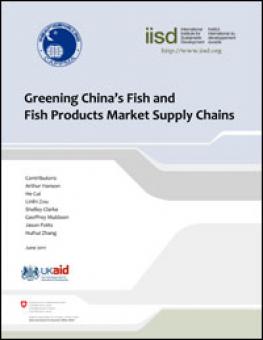
Greening China's Fish and Fish Products Market Supply Chains
Over the past two decades, China's involvement with world fisheries trade in aquatic products has increased dramatically, making it the world's largest producer, consumer and exporter of seafood.
China will play an increasingly important role in securing the long-term sustainability of the seafood sector. China's role in market supply chains is especially important. There is worldwide interest in the greening of these supply chains, taking into account sustainability impacts on species and stocks, as well as ecosystems within China and elsewhere in the supply chains. International certification processes such as those of the Marine Stewardship Council (MSC) and various seafood consumption guides are examples of how this international interest is shifting global production, processing, trade and consumption patterns.
Whatever the direction of China's future expansion of production, import and export, and domestic consumption, it will affect the potential of global aquatic resources to become sustainable in their use and regeneration. There have been campaigns directed to some products processed or used in China, for example, Patagonia toothfish and shark fins. The great range of products, the success with aquaculture (which now exceeds fisheries in scale), and the ability to create a great variety of market supply chains in an adaptive fashion are strengths of the Chinese aquatic trading system. However there are significant weaknesses, such a traceability of reprocessed products, rise in the import of live coral reef fish that are not being sustainably harvested, and aquaculture practices that need to be upgraded.
Examination of three types of market supply chains form the main part of the report: the rise of tilapia aquaculture for export and domestic consumption; the import of cod for processing and re-export to countries in Europe, the USA and elsewhere; and the rapidly expanding luxury trade of grouper reef fish species from Southeast Asia. The economic result has been important, since millions of livelihoods have been maintained or created in the last two decades of expansion into aquaculture and fish processing and re-processing for export. China has been able to add value to its fish products, with high utilization rates of caught fish ("there is no such thing as trash fish in China"), and by extracting novel products such as ingredients for cosmetics and medicines from aquacultured species. The fundamental question is whether the rapid growth can continue, or if China is already experiencing limits as to what it might expect to harvest from the seas, lakes and rivers, and from the flooded lands and other areas where aquaculture takes place. The report reviews other recent studies on Chinese sustainability needs related to the seafood sector. Several recommendations to the Government of China are provided.
Participating experts
Additional downloads
You might also be interested in
Agreement on Climate Change, Trade and Sustainability: A landmark pact for trade and sustainability
The ACCTS pact, signed by Costa Rica, Iceland, New Zealand, and Switzerland, aligns trade and environmental policies, tackling fossil fuel subsidies, eco-labels, and green trade.
The Responsible Agricultural Investment Tool for Agribusiness and Case Studies
This report summarizes a collaboration to support agribusinesses in complying with principles of responsible investment in agriculture and food systems.
Promoting the Development of Agricultural Cooperatives
Governments in the Global South should promote agricultural cooperatives to boost smallholder access to fair markets, finance, and climate resilience.
Navigating Global Sustainability Standards in the Mining Sector
This brief examines the latest developments and trends in responsible mining standards and voluntary sustainability initiatives.